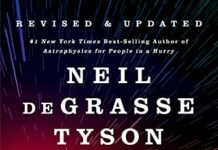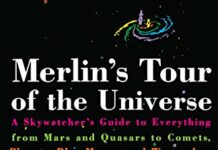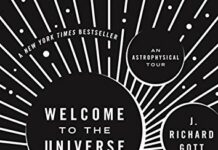
Ebook Info
- Published: 2018
- Number of pages: 576 pages
- Format: PDF
- File Size: 9.83 MB
- Authors: Neil deGrasse Tyson
Description
New York Times Bestseller An exploration of the age-old complicity between skywatchers and warfighters, from the best-selling author of Astrophysics for People in a Hurry.In this fascinating foray into the centuries-old relationship between science and military power, acclaimed astrophysicist Neil deGrasse Tyson and writer-researcher Avis Lang examine how the methods and tools of astrophysics have been enlisted in the service of war. “The overlap is strong, and the knowledge flows in both directions,” say the authors, because astrophysicists and military planners care about many of the same things: multi-spectral detection, ranging, tracking, imaging, high ground, nuclear fusion, and access to space. Tyson and Lang call it a “curiously complicit” alliance. “The universe is both the ultimate frontier and the highest of high grounds,” they write. “Shared by both space scientists and space warriors, it’s a laboratory for one and a battlefield for the other. The explorer wants to understand it; the soldier wants to dominate it. But without the right technology―which is more or less the same technology for both parties―nobody can get to it, operate in it, scrutinize it, dominate it, or use it to their advantage and someone else’s disadvantage.”Spanning early celestial navigation to satellite-enabled warfare, Accessory to War is a richly researched and provocative examination of the intersection of science, technology, industry, and power that will introduce Tyson’s millions of fans to yet another dimension of how the universe has shaped our lives and our world.
User’s Reviews
Editorial Reviews: Review “Extraordinary….A feast of history, an expert tour through thousands of years of war and conquest….Condenses multiple bodies of work into one important, comprehensive and coherent story of the symbiotic developments of astrophysics and war….The lesson is not merely a wake-up call for astrophysicists, but for all of us, for anyone with the misapprehension that science somehow marches on separate from the rest of culture” ― Jennifer Carson, New York Times Book Review”Through ample research and nimble storytelling, Tyson and [Lang] trace the long and tangled relationship between state power and astronomy….Deep and eloquent.” ― Joshua Sokol, Washington Post”Fascinating….Retells the history of space exploration, and of the Cold War, excelling in bringing forth the entangled advances of science and military interests….The book’s message rings like a wake-up call.” ― Marcelo Gleiser, NPR”Archimedes and Leonardo worked for their Departments of Defense, and when the telescope was invented it was an immediate instrument of war. Why do astrophysicists even have jobs? asks Neil deGrasse Tyson. Now you can see the inside story, from early times to the cold war, the Apollo program, spy satellites and the Hubble Space Telescope, the Iraq war, and perhaps asteroid mining. A wonderful book and a fascinating read, full of amazing stories, all backed up with deep scholarship.” ― John Mather, Winner of the Nobel Prize in Physics”A sweeping panoramic overview of the enduring alliance between astrophysics and the military―from the Greeks to Galileo to GPS.” ― Science”Accessory to War is a phenomenal work that should be required reading for policy makers everywhere.” ― William E. Burrows, author of Deep Black: Space Espionage and National Security and This New Ocean: The Story of the First Space Age”This is an indispensable, mind-blowing account about a necessary near-future that is, tragically, not inevitable: that the disciplines of astrophysics and politics unite to forge a new frontier―not through ‘Rumsfeldian-Trumpian truculence,’ or by fattening the military while now starving science and the humanities, or by allowing China to continue to lead the U.S. in ‘worldwide research and development spending.’ These have already killed a supposed American Century. Beautifully combining a clear account of cutting-edge astrophysics and politics with a 3000-year historical perspective, this book deserves not only to be read, but to become a guide for those who hope for a better, survivable, near future.” ― Walter LaFeber, Tisch Distinguished University Professor Emeritus, Cornell University”Throughout history, wars tend to be won by nations that are at the forefront of science. Thus astronomers and physicists have, since ancient times, benefited from an uneasy alliance with the military. This enlightening book explores the history and current implications of this partnership between space science and national security.” ― Walter Isaacson, author of Steve Jobs and professor of history, Tulane University”Accessory to War is not just about astrophysics. It is a readable account of the intersection between science and security policy, complete with historical background and personal insights and anecdotes from America’s most-trusted scientist. This is a much needed read for both policymakers and the public, who in ‘normal’ times know and care too little about science, but in today’s political climate increasingly show disdain for scientific principles that fail to fit their philosophical reality or political goals. Astrophysics is too often perceived as ‘not touching me or my life,’ but this book artfully explains otherwise.” ― Joan Johnson-Freese, professor of national security affairs, Naval War College”A wide ranging and provocative set of observations on the two-way relationship between science-based knowledge and national power, especially power of the military variety, replete with trenchant insights. Tyson and Lang’s hopeful concluding message is on-target―that knowledge-based dominance, either in space or on Earth, is not possible in today’s interconnected world, and that cooperation in the use of our knowledge is the necessary path to planetary well-being.” ― John M. Logsdon, professor emeritus, Space Policy Institute, George Washington University About the Author Neil deGrasse Tyson is an astrophysicist with the American Museum of Natural History, director of its world-famous Hayden Planetarium, host of the hit radio and TV show StarTalk, and the New York Times best-selling author of Astrophysics for People in a Hurry. He lives in New York City. Avis Lang is a research associate at the American Museum of Natural History’s Hayden Planetarium. For half a decade, she edited Tyson’s Natural History magazine column, Universe, parts of which became the basis for his Astrophysics for People in a Hurry, and later edited his anthology Space Chronicles. She lives in New York City.
Reviews from Amazon users which were colected at the time this book was published on the website:
⭐A friendlier vision of space exploration a few decades ago was the largely benign journeys by Captain James T. Kirk and crew on the USS Enterprise with its “warp drive”, though armed with phasers, photon torpedoes, shields and sensor systems for largely defensive purposes.Today’s prospects for the role and uses of space, especially around Earth, are quite different according to Neil deGrasse Tyson and Avis Lang’s 2018 collaboration, “Accessory to War: the Unspoken Alliance between Astrophysics and the Military”.As the authors report, at the core of the debate is the complicated entangled relationship between astrophysicists exploring the visible and invisible aspects of our universe for general learning and the military organizations developing tools of offense and defense at the direction of their political leadership.The national priorities are clearly expressed in their estimated current global funding: astrophysics less than $3 billion while military spending over $1.7 trillion. The point is: regardless of who initiates the research, at some point the learning is likely to be repurposed into military use and possibly weaponized. Could be GPS systems, could be thermonuclear bombs. They mention the entire US Department of Defense 2019 proposed funding would equal the entire NASA funding for its history.This relationship between astrophysics and the military is complicated not only currently but also historically. With that in mind, the book is divided into two sections:• Situational Awareness: four chapters covering primarily the earlier advances in science and technology underpinning the current state of affairs• Ultimate High Ground: five lengthy chapters going through more recent development and its applications for use in space as well as very helpful definitions for terms like radar, laser, maser, CCDs (pixel), ISR (intelligence, surveillance, reconnaissance), NEOs (ear Earth objects) and PHOs (potentially hazardous objects)The amount of detail is overwhelming and probably sufficient for anyone who wants to find support for whatever his or her particular view about national priorities is. Some facts cannot be ignored:• Some 20,000 pieces of space junk are orbiting Earth, like our own rings of Saturn, with destructive potential.• Accuracy of using weapons from space on Earth surface targets is simply not feasible now for a variety of reasons.• The recently touted Space Force as a concept is probably original to Donald Rumsfeld and possibly even before him.• US has been relying on Russian rockets and Soyuz capsules for space missions for some time now at a cost of over $80 million per trip.• US efforts to exclude China from the International Space Station (ISS) have probably pushed China to create and launch its own orbiting space station.• In 2011 China apparently became the top country for satellite launches followed by Russia, then, the US.The real current situation assessment can be found in Chapter 8, “Space Power.” There is a very informative summary of the major countries’ current space programs, including China, Russia, India, Japan and Canada as benchmarks. There is also indication the US may be pulling back on some of its previous lofty goals.One eerie detail is mention of the US Air Force’s description of self-defense, “the 5 D’s of deception, disruption, denial, degradation and destruction.” Seem familiar?Discussion of cyberwarfare and its potential to disrupt satellite communications and weapons programs is cursory. A more detailed review is available in David E. Sanger’s 2018 book, “The Perfect Weapon” (if it helps, here’s the link to my Amazon review: https://www.amazon.com/review/R1JI3Q6OMI76VN/ref=cm_cr_srp_d_rdp_perm?ie=UTF8 )The first section of “Accessory to War” has a conversational popular history tone somewhat like Frederick Lewis Allen’s 1931 work, “Only Yesterday” about the 1920s. The second section shifts to straight ahead chronicling of information but more summary analysis could have helped the points and flow.The book title seems ambivalent about what the authors think the relationship between astrophysics and the military should be, especially regarding the use of space. Is it a good thing or bad? Worth the investment? What and whose motives are prevailing? For that reason reading the book may be a different experience than what one might expect from the cover.Beam me back, Scotty.
⭐Great information, the stories and information provided really open your eyes to the wider world that sits in behind waht most people think about. It’s amazing how connected events are.
⭐I decided that I would give it a shot and I am SO GLAD that I did! Full disclosure, I am a HUGE fan of Neil deGrasse Tyson as I have watched numerous episodes of StarTalk, all of his Joe Rogan interviews and seen him speak on multiple other interviews as well. However, when I read several of the negative reviews, I thought twice about this book and put off buying and reading it. Now, I am having trouble putting it down. Does he ramble? Yes! But, that’s why I love watching his videos and reading his books because you never know what rabbit (or maybe worm) hole you are going to be transported too and that makes for an interesting and unique experience. If you know what you’re getting into and are a fan, then you will LOVE it. If you’re not as familiar with him or are not aware of his style of delivery, then it may be a bit too much. If you are fan of his, then you MUST include this one and ignore the reviews and if you are a patient and inquisitive reader who likes to have an “ah” moment on a consistent basis, then buy this book and read all 400 pages of text and enjoy each one!!
⭐The author outlines one of the greatest contradictions in the enterprise of science, it’s historical uneasy relationship with the military. Be aware that my review comes from a position informedf by just war theory. This means that I do not believe that this uneasy relationship is always a bad thing. It does depend on what the ends of the military applications of science achieves and who those ends benefit. Of course, in the case of the United States, few of its wars fit any defintion of justice, but that’s another discussion for another day.What is important in this work is outlining the relationship between the growth of astrophysics and various military agendas across human history. The book also includes a great deal of material concerning the current relationship particularly in the most powerful nations, USA, China, Russia, etc. This is the place where the book is exceedingly useful, as I am sure most Americans are not aware of how the progress of this relationship has made our continued existence doubtful. The book ends with some prescriptions which if heeded upon by the American public give us a chance, but quite frankly we are at the tipping point, and delaying this needed political change much longer may make averting the extinction of our species no longer something we can stop.Finally, for those with science-phobia, the authors do a very good job of explaining some of the most difficult concepts in a way accessible to the lay audience. I firmly believe that all voting Americans should read this book.
⭐Good read. Easy enough for a lay person like me.
⭐This is the type of book that those interested in extraordinary historical and scientific detail will find both useful and utterly fascinating. However, I don’t recommend it as a “quick read”. I’ve been using it as my “breakfast-time reading” for days, and am only at 19% according to my Kindle. Needless to say, Tyson is not only highly knowledgeable, but – as anyone who has listened to him speak knows – extremely amusing. This is not a book I will give up on, but truthfully I consider it something to be savored, not rushed through.The theme, of course, magnificently developed, is that all the advances made in science – especially astronomy and technology – have been both motivated by and dependent upon the needs of warfare, as well as the more peaceful applications of commerce and the pure curiosity of human nature. The narrative is replete with technical information, but it is presented in easily accessible non-technical language with numerous anecdotes and examples worked in. This book could be called both fun and fundamental.
⭐Very informative and fun to read
⭐Great book
⭐Book seems good although the copy I received was not cut correctly by the printers. Approx 50 pages were joined at the top and had to be cut with a Stanley knife blade
⭐Brilliant book and quick delivery
⭐If you have considered to search for the Authors and this book in particular and reading reviews – you should hit the Buy button now 🙂 – you will not be disappointed at all.This is a eye opener on the War vs Science (Astrophysics) collaboration from the very early times and ages than we might normally think. It is for this reason that this book is an eye opener. War and Science friendship is not a new or modern History timeline phenomenon but as old as first scientific discoveries. And this book tells that story and you will feel like “ohh yes – that should have been obvious” after you read. It also gives the political and social viewpoints – very much required to understand the context and the full effect War Technology has on the World and individual nations. USA is obviously heavy on the writing – again obvious given where USA stands technologically in general and in War technologies. I am from India and I have relished reading it no less and I find it no less relevant.Given the task the author(s) have taken for life – science education for masses – this is an excellent read – for all kind of people from all walks of life. The writing style is anecdotal and historial. You need not be regular book reader or literary person – I am not. If you are a regular Neil reader – this is no less engaging. Thanks to Avis Lang too for the guiding contribution – as Neil said 🙂
Keywords
Free Download Accessory to War: The Unspoken Alliance Between Astrophysics and the Military in PDF format
Accessory to War: The Unspoken Alliance Between Astrophysics and the Military PDF Free Download
Download Accessory to War: The Unspoken Alliance Between Astrophysics and the Military 2018 PDF Free
Accessory to War: The Unspoken Alliance Between Astrophysics and the Military 2018 PDF Free Download
Download Accessory to War: The Unspoken Alliance Between Astrophysics and the Military PDF
Free Download Ebook Accessory to War: The Unspoken Alliance Between Astrophysics and the Military


